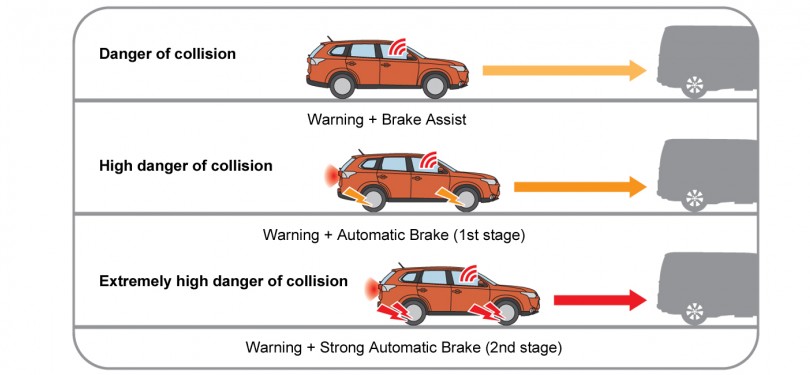An automatic braking system is an important part of safety technology for automobiles. It is an advanced system, specifically designed to either prevent possible collision, or reduce speed of the moving vehicle, prior to a collision with another vehicle, pedestrian or an obstacle of some sort.
These systems combine sensors, such as radar, video, infrared or ultrasonic to scan for possible objects in front of the vehicle, and then use brake control to prevent collision if the object is, in fact, detected.
Automatic brakes are one of many car safety features, and are often integrated with other technology, such as pre-collision systems and adaptive cruise control.
Explaining The Operation

Even though each car manufacturer has its own technology when it comes to automatic braking systems, they all use sensory input as a starting point. Depending on the manufacturer, a system uses sensors such as laser, radar, or even video data, to determine if there are any objects in front of the vehicle. For example, the system monitors traffic in front of the vehicle and assesses the possibility of a collision.
If an object is detected, the system continues with direct measurement of sensor data. It determines the distance between the moving vehicle and the object in front of it, and assesses their relative speed, as well. If the system concludes that there is a significant speed difference, i.e. the speed of the vehicle is greater than the speed of the object on its path, it can automatically activate the brakes, in an attempt to prevent the possible collision.
An automatic braking system can also connect with a vehicle’s GPS system, and use its database of stops signs and other traffic information, in order to activate the brakes in time if the driver fails to.
Each manufacturer uses its own automatic braking system technology, with different sensory input and setup.
Volvo’s City Safety System, on the other hand, uses a combination of a lidar (laser radar), placed in the bumper, and a camera, mounted in the windshield. Lidar can see several hundred yards in front of the car, but it can’t determine what it’s seeing. That’s where the camera steps in, identifying the object and determining if it is a possible problem or not.
Honda’s City Brake Active System combines radar sensors and cameras, using the data to determine any possible collision, and warn the driver through the series of visual and audible alerts. If the driver ignores the warnings, the system can take over and automatically apply the brakes. Honda’s system can detect pedestrians and slow the vehicle down or stop it entirely if there is a chance of pedestrians being hit.
Benefits Of Having An Automatic Braking System
Drivers whose cars are equipped with an automatic braking system don’t drive their cars any differently than any other car. It is there, but it doesn’t bother the driver, and if it comes down to it, it doesn’t even need driver’s input to react.
Sadly, only about 40% of drivers react appropriately and hit the brakes in crashes. It is important to note that the driver ”still has the ability to either push the brake or swerve around. “We want to keep the decision to the driver. But only if the driver doesn’t react at all, the final action is autonomous braking.”
When it comes to driver’s ”sins”, such as distracted driving, inattentiveness, sleepiness, lack of full concentration or using a mobile phone while driving, and even poor driving conditions, visibility and road surface problems, an automatic braking system can not only help reduce property damage in case of an accident, but more importantly, save lives.
It is a great safety net most of the drivers will probably never use. Still, it is a comfort for all drivers to know that even if they fail in protecting themselves, their vehicle won’t.


